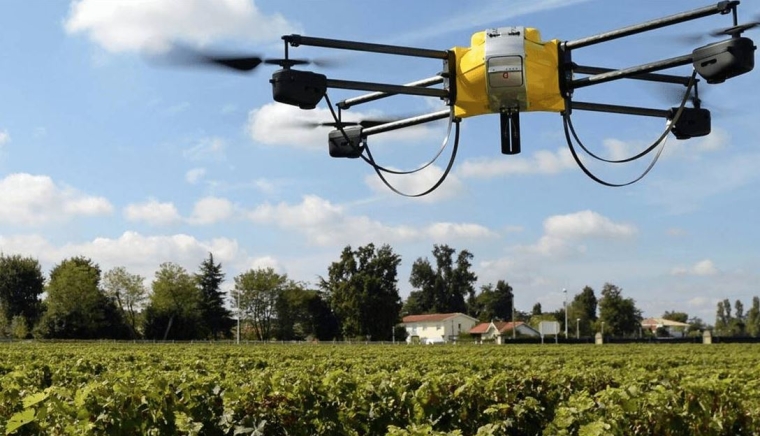
As covered by general media over th epast week, the OECD have released their latest report on New Zealand’s situation in particular in relation to other OECD countries. I went through the document (146 pages) wearing a distinctly rural hat to try and ascertain how New Zealand agriculture was faring (in relation to other countries) as mainstream media had focused largely on the retirement age and how New Zealand had handled the Covid pandemic from a government level.
Most of what the document contains has been said or signalled before in previous reports (Covid excepted) and the ‘work insurance scheme’ which the government announced this week has been one of the continuing themes in previous OECD reports which may indicate that the government does take at least some notice of what they present.
One of the major areas where the report believes improvements to both productivity and underpinning of new exports could be made is in the area of digital technology.
With New Zealand so distant from its export markets the report believes there needs to be more digital training and incentives to build up greater capacity as distance become less of an issue. It specifically targets agriculture as a sector that would benefit from incorporating more digital technology to increase productivity.
They use the graph below to illustrate how the IT industry has outstripped other sectors in recent years.
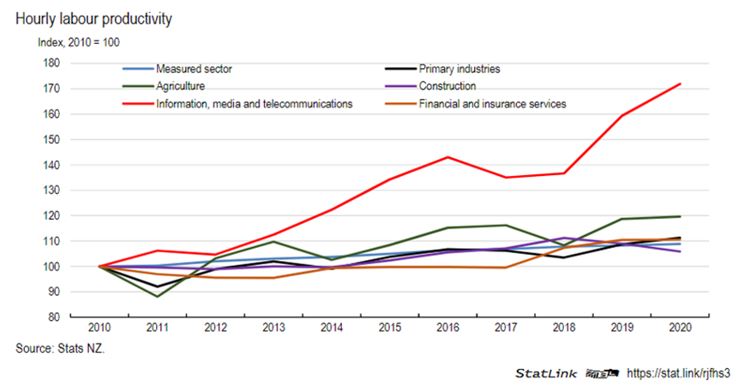
The report highlights the fact that despite having virtually no government support and being highly exposed to international competition (which often do have the benefit of government support) it has performed well and prices are “in line with international prices”. However, improvements in “Total Factor Productivity” are lacking and growth from 2007 -2016 was only 0.7% (to gain an insight in TFP go to link). Lower than many of our competitors including Australia, EU and USA, with most of our growth coming from increased on farm productivity.
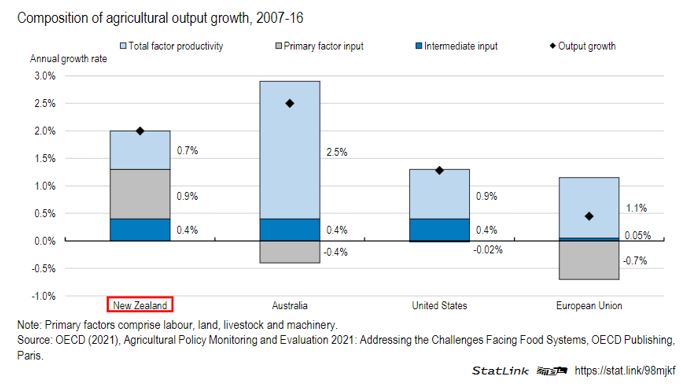
The authors believe this indicates a heavy reliance on migrant labour and a slow adoption of new technologies and innovations.
Given the calls to allow in more migrant workers it is difficult to refute this.
They highlight the consumer preferences are moving towards a more plant based diet, which while may take time is certainly the trend for the future. They believe the use of more digital technologies could improve productivity over time by 21%.
Many in the rural sector would point out that they feel ‘kneecapped’ by the lack of more powerful internet services. Generally, the report says that New Zealand compares well with other OECD countries with strength and coverage. However, New Zealand with its greater reliance on the rural sector for exports is not quite comparing apples with apples as the best coverage is still far and away located in the larger cities. Panel B which shows the area covered by wireless broadband is acknowledged as still developing and ‘holes’ exist and is definitely not at the same quality as fibre.
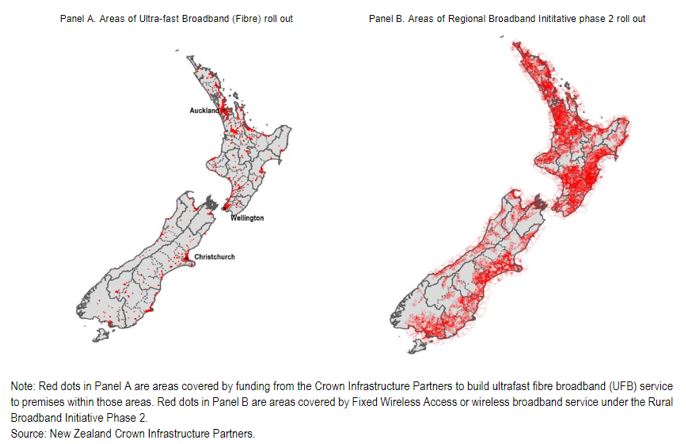
Perhaps surprisingly they found New Zealand’s firm export intensity low for a small country. This translates into the degree of exporting activities measured as the percentage of exports relative to sales. So, while agriculture which by and large exports about 90% of ‘sales’, other sectors are not so active and are perceived to be more at risk of failure as a result.
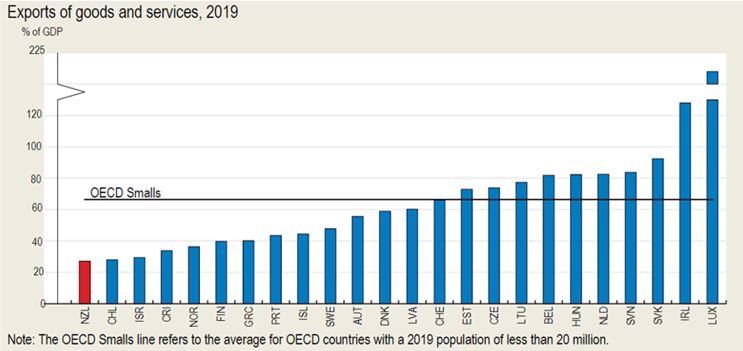
An area farmers are likely to be concerned with is the belief that the report authors not only believe water use should all be monitored and paid for but also be a tradeable right so that it ends up going to its best (economic) use. I would argue that given the high cost of electricity and irrigation schemes making water one of the higher input costs into a farming system that uses irrigation water, this is already occurring. I suspect trading water would be a step too far for the government and likely Māori as a resource partner would also be hesitant to pursue this also, although it could be a good money earner.
On the topic of climate change and greenhouse gases, they highlight the fact that New Zealand are falling well short of where we need to be to meet our international commitments. They steered cleared of targeting livestock farming too much except to recognise that it is the largest emitting sector but will be coming into the ETS (at a lower level) in 2025. They did however state that they saw merit in developing environmental taxes to capture more externalities. They felt that not having a fuel tax on fuels used off road was an oversight that could/should be rectified.
Other areas raised was the low levels of “Foreign Direct Investment” (FDI) coming into the country considering New Zealand’s small size and open economy. (Countries on the left of the graph are the smaller [less than 20m population] OECD countries).
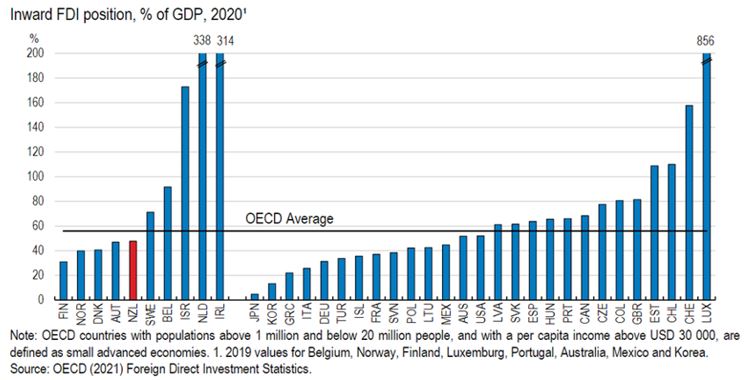
On a similar vein they questioned New Zealand’s corporate tax rate and felt it should align with Australia’s which may keep more business and investment here. Currently our “Statutory” corporate tax is lower than Australia but the marginal tax rate which better reflects the real cost of tax is considerably higher.
Perhaps of interest Australia’s FDI is similar to that of New Zealand, so we do not look to be currently losing much offshore investment to them. Staying on taxes the report has repeatedly called for a ‘Capital Gains Tax” and notes that the ‘bright-line test’ has been extended to 10 years.
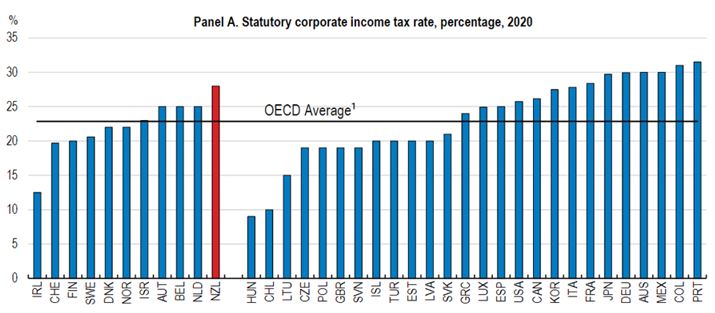
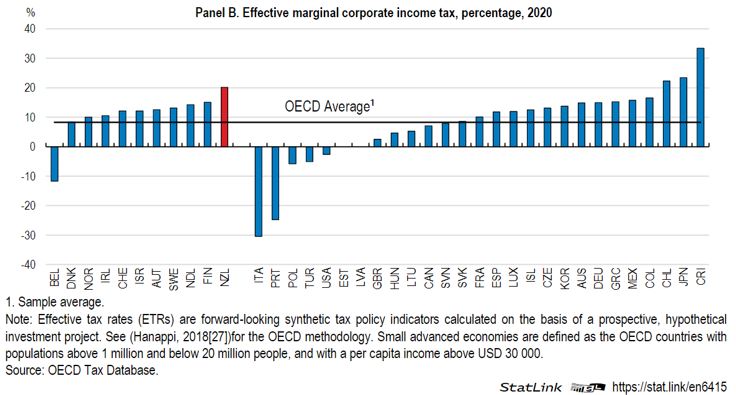
The fact that the government is proposing to adopt a health and work insurance policy similar to other OECD countries (Australia one of the few developed countries that also has not got one) could indicate that government does take notice of these reports. However, any change is likely to be incremental and no great threats appear to be looming, providing my take on water trading is correct.
P2 Steer
Select chart tabs
19 Comments
Other areas raised was the low levels of “Foreign Direct Investment” (FDI) coming into the country considering New Zealand’s small size and open economy.
Paying tribute to foreign lenders is not a way forward since the export of interest and dividends is destructive to our future growth prospects. - witness our expensive dependence on the Australian owned bank industry and other examples such as Wellington Electricity.
Does Foreign Direct Investment Generate Economic Growth? A New Empirical Approach Applied to Spain
It is often asserted with confidence that foreign direct investment (FDI) is beneficial for economic growth in the host economy. Empirical evidence has been mixed, and there remain gaps in the literature. The majority of FDI has been directed at developed countries. Single-country studies are needed, due to the heterogeneous relationship between FDI and growth, and because the impact of FDI on growth is said to be largest in open, advanced developed countries with an educated workforce and developed financial markets (although research has focused on developing countries). We fill these gaps with an improved empirical methodology to check whether FDI has enhanced growth in Spain, one of the largest receivers of FDI, whose gross domestic product growth was above average but has escaped scrutiny. During the observation period 1984–2010, FDI rose significantly, and Spain offered ideal conditions for FDI to unfold its hypothesized positive effects on growth. We run a horse race between various potential explanatory variables, including the neglected role of bank credit for the real economy. The results are robust and clear: The favorable Spanish circumstances yield no evidence for FDI to stimulate economic growth. The Spanish EU and euro entry are also found to have had no positive effect on growth. The findings call for a fundamental rethinking of methodology in economics.
I can't help feeling that NZ ag is running at full capacity now. As fert prices go up it will only decrease on the pastural side. Maybe horticulture could be increased in micro sites. As far as the big items ie grain we have no room to expand. The only place to go is further processing but there is no garantee that customers will pay the extra.
Unfortunaly rather than help farmers we tend to hinder them. They need to be able to continue to do what they do best. In terms of greenhouse gas's, NZ wants to forget this rubbish when it comes to livestock. When you see the hundreds of millions of tons of coal burned around the world every year for electricity generation you see that NZ is not the problem. Sure we should protect the rivers and work towards cleaning them up and keeping them clean but forget the Carbon crap. We are going to need all the food we can get in the coming years.
Future productivity gains will be via robotic assistance especially in horticulture. Laborers will need more skills or go they way of the draught horse.
Spot on. There's some exciting homegrown Agtech companies that show some real promise in areas of automated growing system. I think advancement in AI will play a key role in the success of the sector. There's already interesting crop yield prediction software available to tomato growers.
Automation is definitely the answer for horticulture.
Financialisation of water resources is as absolutely inevitable as carbon tax. Why else would central government be forcibly stripping asset stripping councils using Three Waters?
This is the halcyon era for cheap water rights and control, remember Lang Hancock (Gine Rinehart's father) walking around Western Australia and buying up the best mineral rights? This is that era but with water.
For the love of god. We have a home grown technology, that with the governments help with a wide ranging rollout of, and with the help of the dairy/beef industry groups, would dramatically improve dairy/beef productivity in this country. Farmers using the system report massive increases in productivity, often 40% increase in productivity through:
- No need to have dogs, less need for farm equipment
- No need for fences/raceways, so more pastureland in exactly the same area
- Easy identification of animals with health problems (lame detection etc) using AI
- Easy identification of animals in heat
- Simplified, easy knowledge of where any cow is at any time, no more lost cows or herd crossover
- Less need for staff, less need for them to engage in hard physical tasks (rounding up/fencing etc)
- Automated management
With a whole bunch of potential future enhancements to the product that I can think of, including:
- Automated movements (NAIT/ASD movements performed automatically)
- Pasture to plate technology, enabling consumers of products to see either exactly or approximately where there product was grown
- Potential for use with sheep (I believe they are looking at this too)
Yet the government and industry bodies, who have all seen the technology, simply do nothing. If we really want to do something about productivity of our biggest primary industries, we could. The government simply doesn't know what productivity is, so it could never support a mass subsidsation, rollout and farmer training of said technology, because it wouldn't understand the benefits.
Before anyone asks, I aren't part of the company, but am involved on the compliance side of the industry.
Indeed, I have seen the setup requirements and spoken with the techs specializing in Ag tech used in dairy and while the technology is incredible the government and industry investment in something that increases productivity to award winning levels is still minimal. There are also very limited specialized training courses in the development and use of the technology. Which means less NZders are able to train to use the tech and sadly many will need training for it regardless of previous farming or tech skills.
There are other options already out there for some of that e.g. https://www.allflex.global/nz/product_cat/dairy-cow-monitoring/
It is not up to govt or industry bodies to promote products. It is up to the product to sell itself. Affordability depends on farm system - large corporate/sharemilker/sharefarmer/owner operator. Spoke to a large herd sharemilker - Halter would cost them $100k/yr - not cost efficient for them. They have stable staffing and good rosters.
Fonterra already uses QR codes for traceability on infant formula. https://www.fonterra.com/nz/en/our-stories/media/Anmum-releases-first-b….
As a non herdowner dairy farmer, I have no vested interest in neither Halter nor Allflex.
It sounds very interesting but also very expensive. I'll be interested to see how well it is taken up, it wouldn't be the first or last time that grand claims have been made about increasing production. I don't know anything about the technology but I do know that in farming s#it happens and my general principal is that the more complicated it is, the more likely it is to break and the more expensive to fix. Even the loadrite weigh system on my loader only seems to work half the time and the rest of time is waiting to be fixed. Robotic milking systems sound great until you factor in the losses when something fails or the fact that not all cows can adapt to the system.
In addition to the above comment, we ALSO have a homegrown product, which could be used to significantly reduce greenhouse gas emissions in bovines, known since discovery in 2017, yes 5 years ago. Again, the government is barely working on the problem, spending pathetic amounts in research projects, apparently going as slow as they possibly can. Considering climate change is "the nuclear free moment of this generation", there should currently be dozens and dozens of studies being funded on the subject. Hell 2 that I can think of right now are:
- Studying how the seaweed can be commercially grown, especially around existing aquaculture (as pointed out before, the outputs from existing aquaculture, huge amounts of nitrogen, could be the inputs for mass seaweed growth)
- Studying how to make the seaweed more paletable to bovines, knowing that most can be trained
But again, all we see is dithering. In the face of climate change, we need to accelerate our research on emissions reductions as this directly affects productivity and our future.
I think it drops production by quite an amount, which is a common theme when it comes to climate anything. Every new farming rule the govt has brought out is laser focused on reducing production, seems like they want to make us so unproductive we go out of business. The good news is the TFP is still growing despite the constant hurdles to jump. Methane is probably the only GHG that is in decline in NZ.
Interesting that increase in fertiliser costs etc are partly driven by countries banning them export in favour of local consumers.
What if Nz did a similar thing with our main exports. Instead of WMP we moved to giving local processors first supply to manufacture and export milk product.If there are apparent shortages , what choice do our customers have?
Same with wood , hold back logs , and export timber. might not have the volume , but then that would save us buying carbon credits overseas.
I guess it would depend which markets /products , NZ has the ability to influence the price. at the moment that would be WMP, maybe kiwifruit , and some vegetables.
"The authors believe this indicates a heavy reliance on migrant labour and a slow adoption of new technologies and innovations."
Yes, hard to refute this. Case in point, it's really hard to see the owners or consultant on this farm having interest in upgrading the complete price of $&67 that passes for a cowshed but is common enough on farms. New technology would cut labour requirements in half and open room for other efficiency.
Cheap labour is considered essential, the campaign for 1500 workers from overseas wanted for next spring is just beginning. This is what is considered important spending of our levies and subs.
IMO the opinion of the OECD should be taken with a grain of salt! Will be purely a statistical analysis, not feet on the ground. Farmers are generally fast adopters of new tech. PROVIDED they can see a positive result to their bottom line. Farming is constantly bombarded with new ideas and new tech. Huge claims are made about how amazing most of it is. Generally unproven! When it comes to livestock there is NO substitute for good stockmanship! NONE! This means constant human contact.
That's right DD62, no amount of new tech will increase the amount of stock per hectare any individual farm is capable of carrying.
“” When it comes to livestock there is NO substitute for good stockmanship! NONE! This means constant human contact.””
Quote of the day

We welcome your comments below. If you are not already registered, please register to comment
Remember we welcome robust, respectful and insightful debate. We don't welcome abusive or defamatory comments and will de-register those repeatedly making such comments. Our current comment policy is here.